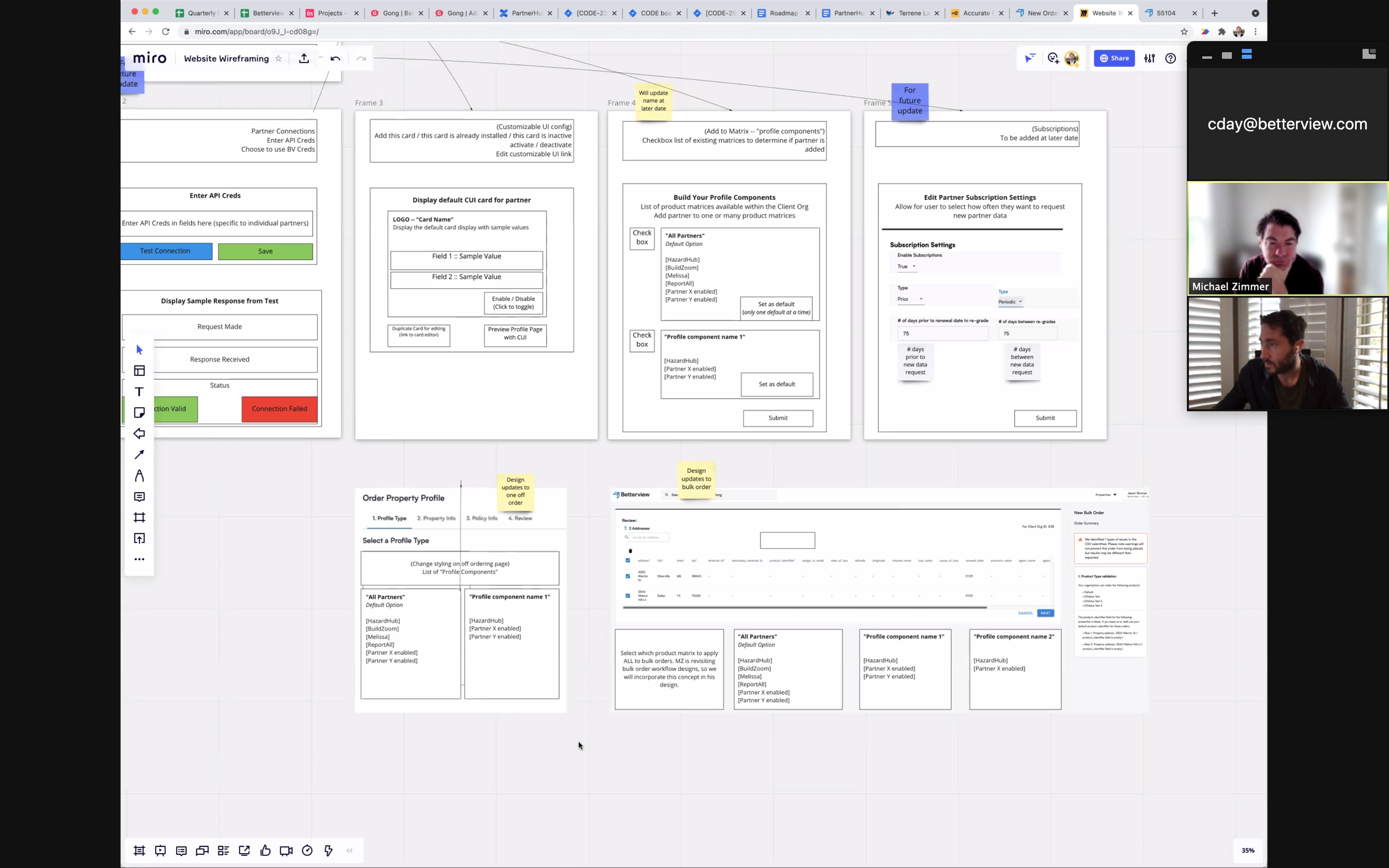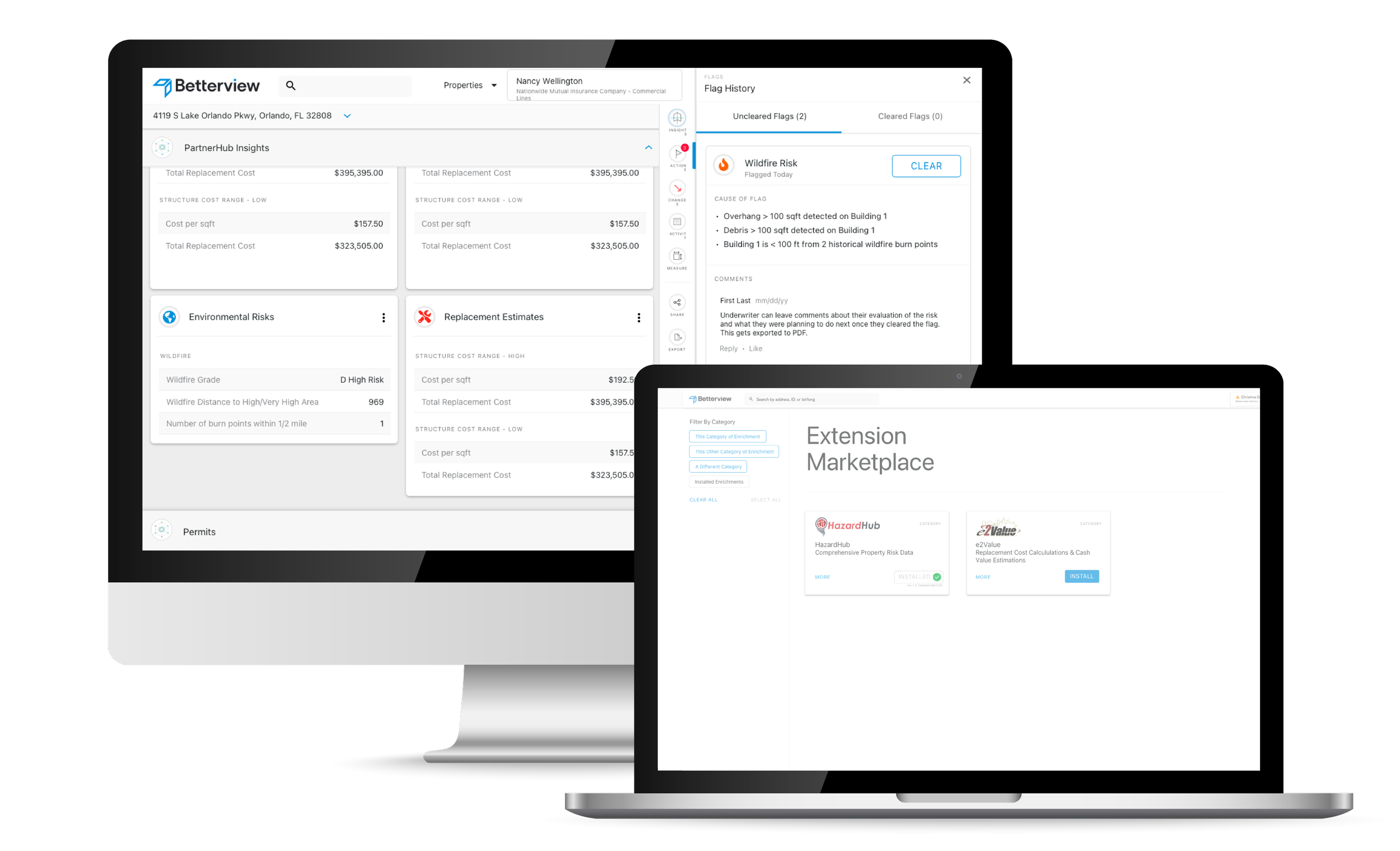PartnerHub – Third-Party Data Integration
Adding value to the Betterview Platform with a revolutionary new product that integrates third-party property data for insurers.
Revolutionizing the integration of third-party property data for insurers through a unique Customizable UI that automates and enhances decision-making workflows.

Complete PartnerHub platform interface showcasing data integration capabilities and customizable dashboard features • Scroll to explore the full interface
Overview
PartnerHub is a pivotal extension of Betterview's platform that revolutionizes how insurers access and utilize third-party property data. This feature centralizes disparate data sources such as geospatial and weather information, automating decision-making workflows and transforming how property risk assessments are conducted.
As the lead UX/Product Designer, I developed an intuitive user experience that streamlines the path from data to actionable insights, enabling underwriters to make more informed decisions with unprecedented efficiency.
The Team
- • 1x UX/Product Designer (Myself)
- • 1x Product Manager
- • 3x Front-End Engineers
- • 2x Back-End Engineers
Research & Discovery
In the initial phase of the PartnerHub project, my focus was on understanding the full spectrum of user needs and the technical landscape. This involved extensive user research to identify the key touchpoints for a frictionless user experience.
The research spanned from onboarding new clients to customizing and exporting data for underwriter use, ensuring every interaction point was optimized for efficiency and usability.
Research Timeline
User Research
- • Conducted interviews with Betterview clients to capture workflow challenges and data usage patterns
- • Analyzed user feedback to determine essential features and interface requirements
- • Mapped critical touchpoints from onboarding to data export
Competitive Analysis
- • Reviewed existing solutions and third-party data integrations
- • Benchmarked against industry standards
- • Identified gaps where PartnerHub could provide competitive edge
Research Scale & Impact
100 online surveys
30 email responses
Direct Clients
Third-party Vendors
60-90 minutes each
Workflow analysis
Technical Exploration & Strategy
- • Collaborated with engineering teams to understand constraints and possibilities
- • Explored technical feasibility of seamless API connections
- • Synthesized research findings to formulate product strategy
- • Prioritized features enabling informed decision-making
This rigorous discovery process laid the groundwork for PartnerHub's design and development, ensuring the solution not only met immediate client needs but also set a new standard for property intelligence platforms in the insurtech marketplace.

Comprehensive user research documentation and findings that informed PartnerHub's design direction.
Design Development
Armed with insights from the discovery phase, the next step was to translate these into a user-centric design. This phase was characterized by iterative prototyping, continuous user testing, and close collaboration with engineering teams.
The challenge was designing for complex data visualization while maintaining an intuitive user experience across multiple third-party data formats.
Design Phase

Collaborative design sessions in Miro showing user flow mapping and team ideation for PartnerHub.
Design Methods
Wireframing
Rapid concept exploration
Sketching
Early ideation and flow mapping
High-Resolution Mockups
Detailed interface design
Interactive Prototypes
User testing and validation
Tools & Applications
Sketch App
Primary design tool
Figma
Collaborative prototyping
Adobe Creative Suite
Asset creation
Miro
User flow mapping and team collaboration
Design Challenges
One of the primary challenges was designing for complex data visualization while maintaining an intuitive user experience. The system needed to accommodate multiple data formats from various third-party sources, each requiring custom UI considerations for optimal presentation and usability.
Key Design Decisions
Modular Interface
Created flexible UI components that could adapt to different data types
Progressive Disclosure
Implemented layered information architecture to prevent cognitive overload
Customizable Layouts
Enabled users to personalize their workspace based on workflow preferences
Visual Hierarchy
Established clear data prioritization through typography and spacing
Collaborative Process
The design development phase involved intensive collaboration sessions with the Product Manager and Director of Design. We conducted regular Miro sessions for user flow prototyping, where team members contributed feedback, mock-ups, and suggestions, ensuring the final design was both technically feasible and user-validated.

Detailed interface design elements showcasing the modular components and data visualization patterns.

The final PartnerHub dashboard interface showcasing customizable data visualization and third-party integrations.
Technical Implementation
With the design refined and validated through rigorous user testing, the focus shifted to technical implementation — the phase where design meets development. This required close collaboration to ensure the vision translated accurately into functional code.

Alternative dashboard configuration showing the platform's flexibility in data presentation and layout customization.
Engineering Collaboration
- • Development sprints with front-end and back-end engineers
- • Translated design blueprints into functional specifications
- • Maintained design integrity while addressing technical constraints
Quality Assurance
- • Thorough testing for robustness and reliability
- • Security and data integrity emphasis
- • Cross-browser and device compatibility testing
Integration Challenges
One of the most significant technical hurdles was integrating PartnerHub seamlessly within the existing Betterview platform while ensuring data from various third-party sources flowed reliably into the system. This required careful API design and robust error handling to maintain system stability.
The collaborative effort between design and engineering was key to delivering a solution that was not only technically sound but also offered a refined user experience that stood out in the insurtech market.
.png)
Development process documentation showing the transition from design concepts to functional implementation • Scroll to explore the full interface
Results
The launch of PartnerHub marked a significant milestone for Betterview, with immediate and measurable results that transformed how property risk assessments are conducted across the platform.
Workflow Automation
PartnerHub automated critical aspects of property risk assessment workflows, reducing manual data aggregation and analysis time for underwriters by an estimated 60%.
Enhanced Decision-Making
By providing comprehensive property risk profiles, the feature empowered insurers to make more informed decisions, improving policy recommendation accuracy.
Business Impact
- • User Engagement: Measurable improvement in platform engagement metrics
- • Client Satisfaction: Received excellent feedback from users noting enhanced efficiency
- • Service Offering: Contributed to Betterview's competitive advantage in the insurtech market
- • Future Innovation: Set foundation for additional third-party integrations
Related Innovation
The implementation of PartnerHub also required developing a new Customizable UI system to accommodate the diverse data modalities. This innovation became a cornerstone feature that enhanced the entire Betterview platform experience.
Key Takeaways
The success of PartnerHub underscores the value of integrating user-centered design with robust technical development. By focusing on real user needs and maintaining close collaboration throughout the development process, we produced a product that not only meets current market needs but also anticipates future industry trends.
This project reinforced the importance of comprehensive user research, iterative design processes, and cross-functional collaboration in creating products that deliver measurable business value while enhancing user experience.